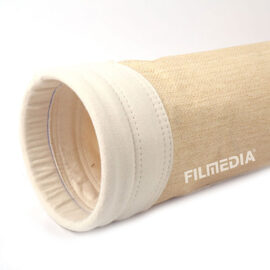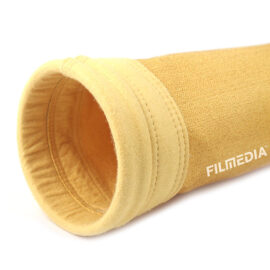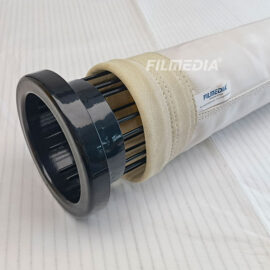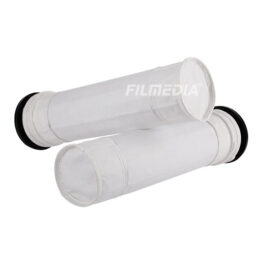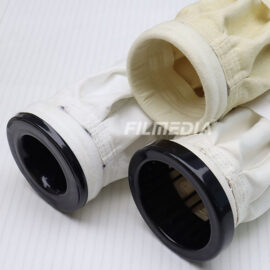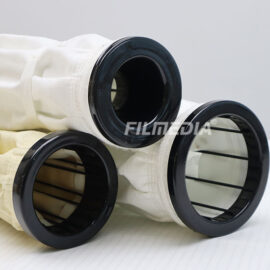The design of the filter bag with snap band to facilitate the replacement and installation of the filter bag while ensuring sealing and filtration effect.
Dust bags are used in a large variety of applications and industries. Especially where dry powder particles need to be filtered from airflow and where particles aren’t allowed to enter the atmosphere. Whether it’s in the food industry or in the chemical,mineral & environmental industry, we offers tailor-made solutions for all kinds of dust collector bags. Filmedia® offer a comprehensive range of filter bags for dust filtration systems in the milling industry On request, customized sizes are available In addition to the standard sizes. Filmedia® manufactures filter sleeves in styles to suit most models and types of dust collectors.Bags fabricated to specification from selected needlefelts and woven fabrics. Our vast range of available felts in various weights and surface treatments, combined with local state-of-the-art manufacturing facilities, allow us to offer you the best solution for your individual application.
Description
The snap band is a device used to secure and seal filter bags and is commonly used in equipment such as filters, vacuum cleaners and air purifiers. Its main functions include the following:
- Fixing the filter bag: The snap band fixes the filter bag to the filter element base or filter bag slot of the equipment to prevent the filter bag from loosening or falling off during operation of the equipment. This ensures that the filter bags work in the correct position and cannot be pulled away by air flow or suction forces.
Sealing performance: Dust filter bag snap bands are usually designed to provide good sealing performance. They ensure a tight fit at the connection points between the filter bag and the equipment, preventing air or dust from bypassing the filter bag and entering the interior of the equipment. This sealing performance is very important for the filtration effect of the equipment. - Prevent air leaks: In equipment such as vacuum cleaners and air purifiers, if the filter bags are not properly secured, air leaks may occur, which is when air, dust or dirt bypasses the filter bags and enters the interior of the equipment or returns to the indoor air. The purpose of the dust filter bag snap band is to ensure that the air inside the device flows through the filter bag, not around it.
- Extended filter bag service life: By properly fixing the filter bag, the filter bag is prevented from being damaged or worn due to vibration or airflow impact while the equipment is running. This can extend the service life of the filter bag, reduce the frequency of replacement, and reduce maintenance costs.
Snap Band Specifications
- Optional materials: carbon steel snap band, stainless steel snap band.
- Diameter: can be customized.
- Width: can be customized.
- Thickness: can be customized.
Filte Bag Materials
| Material | Working Temperature |
Instant Temperature | Abrasion Resistance | Hydrolysis Resistance | Acid Resistance | Alkali Resistance | Oxidation Resistance |
| Polyprolene Needle Felt | 90℃ | 110℃ | Good | Excellent | Excellent | Excellent | Middle |
| Acrylic Needle Felt | 120℃ | 130℃ | Middle | Good | Good | Middle | Good |
| Polyester Needle Felt | 130℃ | 150℃ | Excellent | Poor | Middle | Fair | Good |
| PPS Needle Felt | 180℃ | 200℃ | Good | Excellent | Excellent | Excellent | Fair |
| Aramid Needle Felt | 204℃ | 220℃ | Good | Middle | Middle | Good | Middle |
| P84 Needle Felt | 240℃ | 260℃ | Good | Middle | Middle | Middle | Good |
| PTFE Needle felt | 250℃ | 280℃ | Good | Excellent | Excellent | Excellent | Excellent |
| Fiberglass Needle Felt | 250℃ | 280℃ | Fair | Good | Middle | Fair | Good |
| Woven Fiberglass Filter Cloth | 260℃ | 280℃ | Good | Good | Good | Good | Good |
Applications

Fisolution production methods and facilities are integrated to include verifiable traceability for life. |

Polymers, Resin and Terpene derivatives, Naphthalenesulfonate, Precipitated Silica, Colours, Pigments, Fertilizers. |

Alumina red mud management, cement, chalk, coal,concentrates & tailings (copper, gold, iron, silver, zinc, etc) gravel, gypsum, kaolin & clay, lithium, rare earths (cobalt, bismuth, uranium, etc.) titanium dioxide and many more. |



